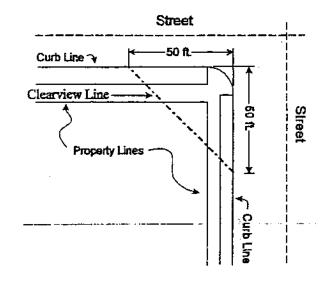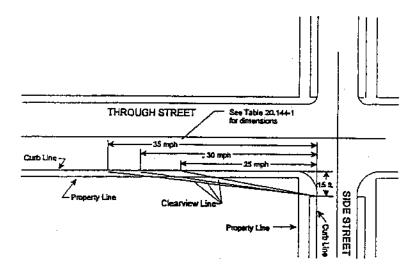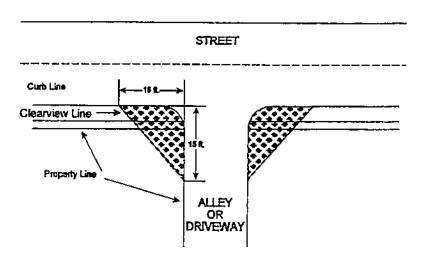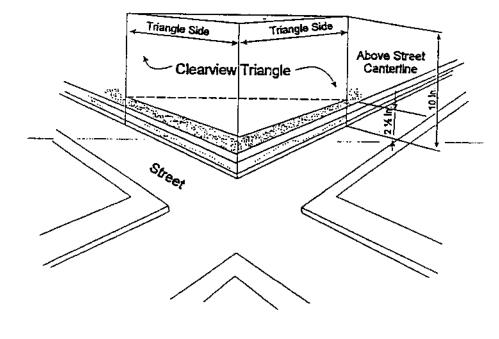Chapter 20.114
CLEARVIEW TRIANGLE
Sections:
20.114.020 Clearview triangle dimensions.
20.114.030 General requirements.
20.114.050 Clearview triangles – Increase by site plan review committee.
20.114.070 Violations, deemed nuisance.
20.114.080 Abatement required.
20.114.010 Purpose.
The purpose of this Chapter is to establish Clearview Triangle requirements to help maintain pedestrian and vehicular safety. Clearview requirements apply to all zones, except Central Commercial and apply to public streets, private streets intersecting with public streets, alleys, railroad crossings, driveways, and curb cuts.
20.114.015 Definitions.
For the purpose of this Chapter, certain abbreviations, terms, phrases, words and derivatives shall be construed as follows:
All-way Stop Controlled. This is the same as a 4-way Stop, except that it applies equally to intersections with three, four, five or more intersecting streets. It means that all vehicles must come to a complete stop before entering the intersection and that they yield to other vehicles that have the right of way.
Four-way Stop controlled. This is the traditional four leg intersection where traffic on all four legs come to a complete stop before entering the intersection and that they yield to other vehicles that have the right of way.
Two-way Stop controlled. This is the traditional intersection of at least two streets where the traffic on one street is required to stop while traffic on the other does not stop.
Uncontrolled Intersection. This is the typical neighborhood street intersection, where traffic volumes are low and traffic on neither is given the right of way over the other. The basic rule of driving governs traffic entering the intersection.
20.114.020 Clearview triangle dimensions.
A. Uncontrolled Intersections. At uncontrolled intersections, the clearview triangle shall be formed by measuring from the intersection of the extended curbline or the traveled right-of-way (if no curbs exist) of the adjacent street to a distance of fifty feet from the corner point. The third side of the triangle is the straight line connecting the two fifty-foot sides. See Figure 20.114-1, Uncontrolled Intersection.
Figure 20.114-1 Uncontrolled Intersection
B. Controlled Intersections. At signalized, all-way stop, two-way stop and yield controlled right angle intersections, the stop or yield controlled street side of the clearview triangle shall be a distance of fifteen feet measured from the intersection of the extended curbline or the traveled right-of-way (if no curb exists). The major street side of the triangle shall be a factor of the posted speed of the major street as noted in Table 20.114-1 measured along the extended curbline or the traveled right-of-way (if no curb exists). The third side of the triangle is the straight line connecting the above defined lines. (Refer to Figure 20.114-2, Controlled Intersection.) Where the intersection of the two streets forms an angle other than a right angle, the sight distance measurement along the major street shall be determined by the city engineer based upon a traffic study. In no case will the acute angle sight distance be less than those shown in Table 20.114-1.
|
Table 20.114-1 Controlled Intersection Major Street Distances |
|
|---|---|
|
Posted Speeds |
Distance along Curbline |
|
25 |
85 feet |
|
30 |
110 feet |
|
35 |
130 feet |

Figure 20.114-2, Controlled Intersection
C. Alley and Driveway Intersections with Public Right-of-Way.
1. All lots which abut alleys and all private driveways shall maintain a clearview triangle. The sides of the triangle forming the corner angle shall be fifteen feet measured along the extended curbline (or the traveled right-of-way if no curbs exist) and along the edge of the driveway or alley. The third side of the triangle is the straight line connecting the two fifteen-foot sides.
2. The area between the triangle and the edge of the traveled right-of-way of the street shall also be kept clear of visual obstructions as outlined in Section 20.114.030.
3. Figure 20.114-3, Alley or Driveway Intersection, illustrates the requirements of this section.

Figure 20.114-3, Alley or Driveway Intersection
(Ord. 2023-33 § 5, 2023).
20.114.030 General requirements.
On property located within any clearview triangle, there shall be located no structure, fence, wall, hedge, natural growth, tree, sign, or other visual obstruction in excess of ten inches in diameter or which materially impairs vision between a height of two and one-half feet and ten feet above the grade street centerline, or curb top if one is present. See Figure 20.114-4, Clearview Triangle Perspective.

Figure 20.114-4, Clearview Triangle Perspective
20.114.040 Exemptions.
Clearview triangle regulations of this chapter shall not apply to:
A. Buildings which were existing prior to passage of the ordinance codified in this code;
B. Public utility poles;
C. Trees, so long as they are not planted in the form of a hedge and are trimmed to the trunk to a height of at least ten feet above the grade level of the centerline of the intersection so as to leave, in all seasons, a clear and unobstructed cross view;
D. Official warning signs or signals;
E. Properties where the existing contour of the ground penetrates above the maximum two and one-half feet height limitation noted in Section 20.114.030;
F. Properties located in the Central Commercial (CC) zone as established in Chapter 20.50 and delineated on the official zoning map of the city;
G. Woven wire-chain link fences provided that there is no other landscaping or visual obstruction.
20.114.050 Clearview triangles – Increase by site plan review committee.
The clearview requirement may be increased by the site plan review committee in areas of unusual circumstances. For example, streets permitting high speed travel or with excessive curves may require a larger field of vision.
20.114.060 Adjustments.
In the event street improvements change the width of the traveled way, or locations of curbs, Clearview triangles shall be adjusted to meet the requirements of this chapter.
20.114.070 Violations, deemed nuisance.
Any structure, fence, wall, hedge, natural growth, tree, sign, or other object erected or placed in violation of the clearview triangle requirements of this chapter, is declared to be a public nuisance.
20.114.080 Abatement required.
Abatement shall be as set forth in Chapter 8.07, Nuisance Procedures (Ord. 00-02, February 9, 2000).


